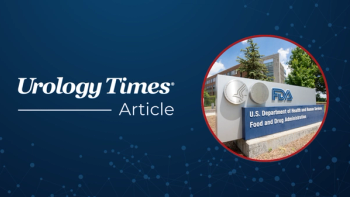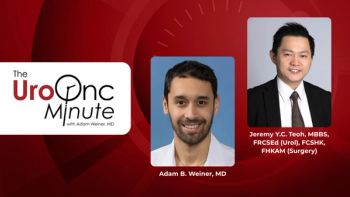
GLP-1 agonist use is rising in men with prostate cancer
Key Takeaways
- GLP-1 and GIP/GLP-1 receptor agonist use in prostate cancer patients has increased significantly over the past decade.
- Usage patterns are influenced by age and socioeconomic vulnerability, with younger and less socioeconomically vulnerable patients more likely to receive these medications.
In 2015, 1245 patients had prostate cancer and had also initiated a GLP-1 or GIP/GLP-1 receptor agonist compared with 69,808 patients in 2024.
A large, retrospective study of nearly 200,000 patients with prostate cancer from the Epic Cosmos database revealed a rise in the use of GLP-1 and GIP/GLP-1 receptor agonists over the past decade, with usage patterns influenced by age and socioeconomic vulnerability.1
The findings were presented in a poster at the
By the way of background, the investigators, led by Amy Shaver, PhD, PharmD, MPH, a postdoctoral fellow at Thomas Jefferson University in Philadelphia, Pennsylvania, wrote, “The use of glucagon-like peptide 1 receptor agonist (GLP-1) and dual glucose-dependent insulinotropic polypeptide (GIP) and GLP-1 (GIP/GLP-1) receptor agonist classes has increased substantially over the past several years for treating both type 2 diabetes (T2DM) and obesity. The GLP-1 receptor is expressed in metastatic prostate cancer, and both GLP-1 and GIP/GLP-1 receptor agonist medications may have an impact on prostate cancer outcomes. However, a use analysis among patients with prostate cancer in a large, diverse, and current real-world database has not been published.”
To this end, the investigators conducted a national, retrospective study that evaluated data on patients in the Epic Cosmos database with an active diagnosis of prostate cancer who initiated a GLP-1 or GIP/GLP-1 receptor agonist medication between January 1, 2015 and December 31, 2024. The primary end point of the study was percent use and change in use over time; secondary end points were factors associated with use.
The investigators included a total of 197,459 patients with prostate cancer who had initiated a GLP-1 or GIP/GLP-1 receptor agonist. Median age was 75 years.
In 2015, 1245 patients had prostate cancer and had also initiated a GLP-1 or GIP/GLP-1 receptor agonist compared with 69,808 patients in 2024. A total of 1178 patients had T2DM in 2015 (representing 87.13% of the prostate cancer/GLP-1 or GIP/GLP-1 population at the time) vs 56,649 patients in 2024 (representing 81.15% of the prostate cancer/GLP-1 or GIP/GLP-1 population at the time). Body mass index was lower than 30 kg/m2 in 349 patients in 2015 (representing 28.03% of the prostate cancer/GLP-1 or GIP/GLP-1 population at the time) and 26,092 patients in 2024 (representing 37.38% of the prostate cancer/GLP-1 or GIP/GLP-1 population at the time). BMI was 30 kg/m2 or higher in 896 patients in 2015 (representing 71.97% of the prostate cancer/GLP-1 or GIP/GLP-1 population at the time) and 46,241 patients in 2024 (representing 66.24% of the prostate cancer/GLP-1 or GIP/GLP-1 population at the time). Absence of T2DM along with a BMI of less than 30 kg/m2 was observed in 19 patients in 2015 (representing 1.53% of the prostate cancer/GLP-1 or GIP/GLP-1 population at the time) and 3033 patients in 2014 (representing 4.34% of the prostate cancer/GLP-1 or GIP/GLP-1 population at the time).
For patients who received a diagnosis of T2DM, those with a social vulnerability index (SVI) percentile of less than 25 were 20% more likely to receive a GLP-1 or GIP/GLP-1 receptor agonist compared with patients with T2DM who had an SVI percentile of 75 or higher (Odds ratio [OR], 1.20; 95% CI: 1.16-1.24). The investigators also reported that the odds of receiving a GLP-1 or GIP/GLP-1 receptor agonist were 59% lower in patients at least 65 years of age or older with T2DM compared with patients younger than 65 years of age (OR, 0.41; 95% CI: 0.40-0.42). Finally, the odds of receiving an opioid medication were reported to be 14% higher for patients with T2DM who were receiving a GLP-1 or GIP/GLP-1 receptor agonist vs patients who were not receiving a GLP-1 or GIP/GLP-1 receptor agonist (OR, 1.14; 95% CI: 1.12-1.16).
“This Epic Cosmos study showed that GLP-1 receptor agonist and GIP/GLP-1 receptor use is rising. Use is associated with age and social vulnerability,” the investigators concluded.
REFERENCE
1. Shaver AL, Zarrabi KK, Nikita N, Kelly WK, Lu-Yao G. Use of GIP and GLP-1 receptor agonists in prostate cancer patients. J Clin Oncol. 2025;43(suppl 17):5024. doi:10.1200/JCO.2025.43.16_suppl.5024
Newsletter
Stay current with the latest urology news and practice-changing insights — sign up now for the essential updates every urologist needs.



















